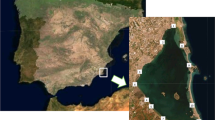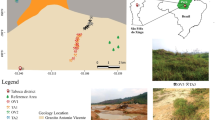Abstract
The Shengli River–Changshe Mountain oil shale zone represents a potentially large marine oil shale resource in China. With the aim of better understanding the geochemistry of trace elements in marine oil shale and its combustion residues, 40 raw samples, 27 oil shale combustion residues and 29 selected minerals from Changliang Mountain oil shale are studied for geochemical analyses. The contents of Se, Cd, Mo, As, Cs, Pb, Sr and U in the oil shale samples are enriched from 1.47 to 33.91 times as compared with the Clarke values, whereas the concentrations of other elements are slightly higher/lower than the respective worldwide means. The most enriched elements in oil shale combustion residues are Se, Cd, Mo, As and U with enrichment values from 4.78 to 50.92. Trace elements with high volatile behaviour such as As, Co, Ni, Sc, Sn and V occur predominantly in organic matter and/or sulphides. Other non-volatile or slightly volatile trace elements (e.g., Be, Bi, Cs, Cu, Ga, Hf, Li, Nb, Rb, Ta, Th, W, Zr and REEs) may occur mainly in original and relatively refractory minerals in raw oil shale. The potentially hazardous trace elements in Changliang Mountain oil shale include As, Cd, Mo and Se. Arsenic and Se are controlled mainly by Fe-bearing minerals (probably pyrite) in Changliang Mountain oil shale. Cadmium is present mainly in dolomite, while Mo occurs mainly in organic matter.


Similar content being viewed by others
References
Alexakis D (2011) Diagnosis of stream sediment quality and assessment of toxic element contamination sources in east Attica, Greece. Environ Earth Sci 63(6):1369–1383
Booth CA, Spears DA, Krause P, Cox AG (1999) The determination of low level trace elements in coals by laser ablation-inductively coupled plasma-mass spectrometry. Fuel 78(14):1665–1670
Dai SF, Ren DY, Tang YG, Yue M, Hao LM (2005) Concentration and distribution of elements in Late Permian coals from western Guizhou Province, China. Int J Coal Geol 61(1–2):119–137
Dinelli E, Tateo F (2002) Different types of fine-grained sediments associated with acid mine drainage in the Libiola Fe–Cu mine area (Ligurian Apennines, Italy). Appl Geochem 17(8):1081–1092
Drahota P, Mihaljevič M, Grygar T, Rohovec J, Pertold Z (2011) Seasonal variations of Zn, Cu, As and Mo in arsenic-rich stream at the Mokrsko gold deposit, Czech Republic. Environ Earth Sci 62(2):429–441
Dyni JR (2006) Oil shale developments in the United States. Oil Shale 23(2):97–98
DZ/T 0223-2001 (2001) Geology Mineral Industry Standard of P. R. China: the general analysis rules for inductively coupled plasma mass spectrometry (in Chinese)
DZG 20.10-1990 (1990) Geology Mineral Industry Standard of P. R. China: rock and mineral analysis (in Chinese)
Finkelman RB (1994) Modes of occurrence of potentially hazardous elements in coal: levels of confidence. Fuel Process Technol 39(1–3):21–34
Fu XG, Wang J, Qu WJ, Duan TZ, Du AD, Wang ZJ, Liu H (2008) Re-Os (ICP-MS) dating of marine oil shale in the Qiangtang basin, northern Tibet, China. Oil Shale 25(1):47–55
Fu XG, Wang J, Zeng YH, Tan FW, Feng XL (2010a) REE Geochemistry of marine oil shale from the Changshe Mountain area, northern Tibet, China. Int J Coal Geol 81(3):191–199
Fu XG, Wang J, Tan FW, Chen M, Chen WB (2010b) The Late Triassic rift-related volcanic rocks from eastern Qiangtang, northern Tibet (China): age and tectonic implications. Gondwana Res 17(1):135–144
Fu XG, Wang J, Zeng YH, Tan FW, Feng XL (2011) Concentration and mode of occurrence of trace elements in marine oil shale from the Bilong Co area, northern Tibet, China. Int J Coal Geol 85(1):112–122
Fu X, Wang J, Zeng Y, Tan F, Feng X (2012) Trace elements in marine oil shale from the Changshe Mountain area, northern Tibet, China. Energy Sources Part A 34(24):2296–2306
Gluskoter HJ, Ruch RR, Miller WG, Cahill RA, Dreher GB, Kuhn JK (1977) Trace elements in coal: occurrence and distribution. Ill State Geol Surv Urbana Ill Circ 499:154
Huang YJ, Jin BS, Zhong ZP, Xiao R, Tang ZY, Ren HF (2004) Trace elements (Mn, Cr, Pb, Se, Zn, Cd and Hg) in emissions from a pulverized coal boiler. Fuel Process Technol 86(1):23–32
Kapp P, Yin A, Manning CE, Harrison TM, Taylor MH, Ding L (2003) Tectonic evolution of the early Mesozoic blueschist-bearing Qiangtang metamorphic belt, central Tibet. Tectonics 22(4):1043
Keshavarzi B, Moore F, Rastmanesh F, Kermani M (2012) Arsenic in the Muteh gold mining district, Isfahan, Iran. Environ Earth Sci 67(4):959–970
Kimura T (1998) Relationships between inorganic elements and minerals in coals from the Ashibetsu district, Ishikari coal field, Japan. Fuel Process Technol 56(1–2):1–19
Liu Y, Liu HC, Li XH (1996) Simultaneous precise determination of 40 trace elements in rock samples using ICP-MS. Geochemica 25(6):552–558 (in Chinese with English abstract)
Liu SQ, Wang YT, Yu L, Oakey J (2006) Volatilization of mercury, arsenic and selenium during underground coal gasification. Fuel 85(10–11):1550–1558
Liu GJ, Zheng LG, Zhang Y, Qi CC, Cheng YW, Peng ZC (2007) Distribution and mode of occurrence of As, Hg and Se and Sulphur in coal Seam 3 of the Shanxi Formation, Yanzhou Coalfield, China. Int J Coal Geol 71(2–3):371–385
Patterson JH, Ramsden AR, Dale LS, Fardy JJ (1986) Geochemistry and mineralogical residences of trace elements in oil shales from Julia Creek, Queensland, Australia. Chem Geol 55(1–2):1–16
Song DY, Qin Y, Zhang JY, Wang WF, Zheng CG (2007) Concentration and distribution of trace elements in some coals from northern China. Int J Coal Geol 69(3):179–191
Tayor SR, McKennan SM (1995) The geochemical evolution of the continental crust. Rev Geophys 33(2):241–265
Vassilev SV, Vassileva CG (1997) Geochemistry of coals, coal ashes and combustion wastes from coal-fired power stations. Fuel Process Technol 51(1–2):19–45
Vassilev SV, Eskenazy GM, Vassileva CG (2001) Behaviour of elements and minerals during preparation and combustion of the Pernik coal, Bulgaria. Fuel Process Technol 72(2):103–129
Wagner NJ, Hlatshwayo B (2005) The occurrence of potentially hazardous trace elements in five Highveld coals, South Africa. Int J Coal Geol 63(3–4):228–246
Wang CS, Zhang SN (1987) The discovery of oil shales in the Shuanghu area, northern Tibet, China. Geol China 8:29–31 (in Chinese)
Wang L, Reddy KJ, Munn LC (1994) Geochemical modeling for predicting potential solid phases controlling the dissolved molybdenum in coal overburden, Powder River Basin, WY, USA. Appl Geochem 9(1):37–43
Yin A, Harrison TM (2000) Geologic evolution of the Himalayan-Tibetan Orogen. Annu Rev Earth Planet Sci 28:211–280
Acknowledgments
This work was supported by the National Natural Science Foundation of China (No. 41172098, 40972087, 40702020), the Sichuan Youth Science & Technology Foundation (No. 09ZQ026-006), and the National Oil and Gas Special Project (No.XQ-2009-01).
Author information
Authors and Affiliations
Corresponding author
Electronic supplementary material
Below is the link to the electronic supplementary material.
12665_2012_2199_MOESM1_ESM.doc
Supplementary Table 1: Concentrations of trace elements in raw samples from Changliang Mountain oil shale (unit in μg/g). Supplementary Table 2: Concentrations of trace elements in oil shale combustion residues (unit in μg/g). Supplementary Table 3: Concentrations of trace elements in isolated minerals studied (unit in μg/g). (DOC 666 kb)
Rights and permissions
About this article
Cite this article
Fu, X., Wang, J., Zeng, Y. et al. Trace elements and their behaviour during the combustion of marine oil shale from Changliang Mountain, northern Tibet, China. Environ Earth Sci 70, 1125–1134 (2013). https://doi.org/10.1007/s12665-012-2199-5
Received:
Accepted:
Published:
Issue Date:
DOI: https://doi.org/10.1007/s12665-012-2199-5




